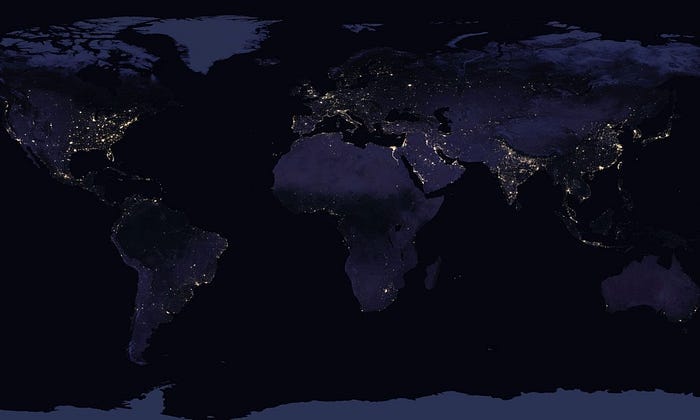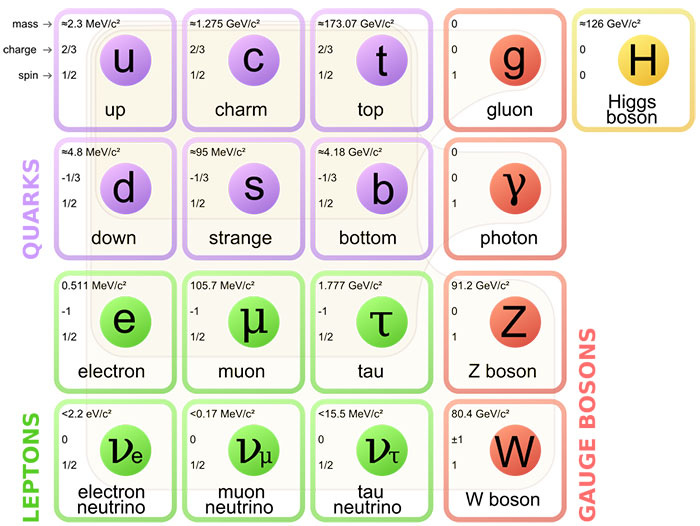3 Uncertainties Of The Universe & How Close We Are To Solving Them
What the muon-g2 experiment reveals & how close we are to discovering dark energy, dark matter & anti-matter from the Big Bang

It’s an exciting time in the realms of particle physics in 2024 because we just might be seeing the next evolution of the standard model that has been theorised in the best part of the 20th century by work from physicists leading from Einstein, Heisenberg, Wheeler, Hawking, Lemaitre, Freidmann & of course if you’ve seen the movie, Oppenheimer & several other physicists as well.
There are three major mysteries or uncertainties that we’ve encountered in particle physics & theoretical physics that are being experimented with, tested & and trying to be observed & understood. These three main uncertainties are — i) Dark Energy ii) Dark Matter & iii) Anti-matter.
In this article, I will briefly delve into the three concepts & explain an experiment that is bringing us closer to understanding them. So read on…
From The Big Bang To Dark
The reason these three concepts are so mysterious is because we haven’t directly observed them but we know they’re out there. As I’ve explained in an old post, by using the example of the image below— it’s like looking at a map of the Earth by night & seeing all the light from the energy we’re consuming on the map, but we can’t see the mountains, hills, oceans & rivers, they’re blacked out, but we know they’re there. It’s a similar case with Dark Energy, Dark Matter & Anti-Matter when we observe space.
Dark Energy
So what is Dark Energy? Simply put, it’s the energy that we can’t seem to detect that is leading to the expansion of the universe at a more accelerated rate. It’s also suffusing space & repelling gravity i.e. it pushes the universe apart instead of pulling it back together. Since the Big Bang, the universe has been continually expanding, but Dark Energy is making it expand faster.
Imagine the Big Bang as a firework explosion. After the firecracker explodes & all of the light & heat gets emitted & only the smoke remains, both physically and as a form of energy. This smoke being left behind is what we’ve theorised as Dark Energy. Furthermore, this smoke is making the universe expand that bit faster.
Roughly 68% to 74% of the universe is made up of Dark Energy, as per estimates.
As NASA’s website states:
”Since the late 1920s, astronomers have known that the universe is expanding. In the 1990s, observations of distant star explosions, called supernovae, showed that the universe expanded more slowly in the past than it does now (i.e. it’s faster now). The reason for this remains unclear, but the leading explanation is that the universe contains something that has a repulsive gravitational effect – it pushes the universe apart instead of pulling it back together. This phenomenon is called dark energy.”
“Dark energy may compose roughly 68% of the universe, but scientists know even less about it…But something like dark energy must exist to explain the universe’s accelerating expansion.”
The Dark Energy model fits perfectly into what Einstein described as the cosmological constant but newer research (as of April 2024) is showing, however, that Dark Energy is not constant & is weakening, which has its own ramifications that I intend to explore in another article.
Dark Matter
While 68% to 74% of the universe is Dark Energy, roughly 21% to 27% of the universe seems to comprise a form of matter known as Dark Matter.
Just like the mountains, valleys & oceans on the map of the Earth in darkness, it’s the matter that supposedly seems to be there in the universe but which we can’t detect.
As NASA’s official website reads:
“Like ordinary matter, dark matter takes up space and holds mass. But it doesn’t reflect, absorb, or radiate light – at least not enough for us to detect yet.”
“Astronomers didn’t even know dark matter existed until the 20th century. In the 1930s, Swiss astronomer Fritz Zwicky coined the term while studying the Coma galaxy cluster, which contains more than 1,000 galaxies. The speed at which galaxies within a galaxy cluster move depends on the cluster’s total mass and size. Zwicky noticed that galaxies in the Coma cluster were moving faster than could be explained by the amount of matter astronomers could see there.”
“It wasn’t until the 1970s that U.S. astronomer Vera Rubin confirmed the existence of dark matter by studying how individual galaxies rotated. She and her colleagues found that individual galaxies may contain invisible mass made of dark matter.”
“Scientists today think dark matter exists in a vast, web-like structure that winds through the whole universe – a gravitational scaffold that attracts most of the cosmos’ normal matter. They’ve determined that dark matter isn’t composed of known particles of matter because the universe would look very different if it were. The search for what makes up dark matter continues……”
Anti-Matter
So if about 70% of the universe is dark energy and approximately 25% is dark matter, in terms of the total energy contained in the universe, that leaves just roughly 5% of the universe comprising matter i.e. stars, planets, galaxies, etc. So from our observations & calculations, we know only what 5% of the observable universe contains, the rest is ‘dark’ & spookily unknown.
However, the third uncertainty arises from all the missing anti-matter after the Big Bang.
Just like an everyday battery has a positive & negative charge — we know electrons have a negative charge & they have their anti-matter counterpart i.e. the positron which is positively charged. All subatomic particles have their corresponding anti-particle just like the photon & positron or the proton and anti-proton.
All particles, even those that flow through your body have their corresponding anti-particles. However, after the Big Bang and all the matter it created, there seems to be a huge void of anti-matter from the Big Bang that’s missing.
As it reads on the official CERN page:
“The Big Bang should have created equal amounts of matter and antimatter in the early universe. But today, everything we see from the smallest life forms on Earth to the largest stellar objects is made almost entirely of matter. Comparatively, there is not much antimatter to be found. Something must have happened to tip the balance. One of the greatest challenges in physics is to figure out what happened to the antimatter, or why we see an asymmetry between matter and antimatter.”
How We Can Potentially Solve These Three Mysteries Of The Universe? — The Muon
However, as of 2021 some exciting progress in particle physics (much like dark energy) is accelerating our understanding of these three major mysteries or anomalies of the universe.
“So those are three of the big mysteries about our universe. And that's a lot of what we don't know. Now, what this means is our current understanding of the universe, up until this point, can't tell us why the universe is the way it is, or what 95 percent of it is made of.”
“But importantly, each of these mysteries — what is dark energy, what is dark matter and the matter-antimatter asymmetry in the universe — could all be solved by finding a new particle or a new force of nature.” says particle physicist Alex Keshavarzi.
The Muon, which is a fundamental particle in the standard model, has been put through an experiment called the “muon g2 experiment” to find whether the standard model of particles holds good or if there are other forces & particles that we haven’t discovered yet… and the result is amazing (Read on….)
“And so it's at this point that I'd like to introduce you to a particular particle, and the hero of our story, the muon. Now, muons may seem unfamiliar to you all, but actually, they’re around us all the time. Cosmic rays that hit the Earth's atmosphere result in showers of muons that constantly bombard the Earth. You may be surprised to learn, for example, that there are, on average, 30 muons traveling through each and every one of you every second.”
“Now, muons can be thought of, quite simply, as the heavy cousin of the electron, and they sit next to the electron in this picture, and they're about 200 times heavier. But importantly, they’re an ideal tool for physicists to use to search and look for new particles and forces to explain those big mysteries.”
”And so why is that? Well, let's assume for a second that we can represent a muon by this gyroscope. When you spin a gyroscope, it wobbles around its axis, just like that.”
“And muons have an identical behavior when you place them in a magnetic field, they spin and they wobble. Now whilst they're doing this, the muon will come into contact with any and all other particles in the universe, standard model or otherwise. And in fact, it's the interaction of the muon with those other particles that defines how fast it wobbles. In essence, the more different particles that bounce off the muon whilst it is wobbling, the faster it will wobble.”
“This experiment with the Muon aims at deciphering particles & forces based on how muons wobble in a magnetic field by interacting with the other fundamental particles & forces explained in the standard model.”
“And so then this is what we want to measure — how fast muons wobble in a magnetic field due to their interaction with all the particles and forces in the universe. Now so far, no new particle or force outside of the standard model that could explain those big mysteries about our universe has ever been discovered. But the point to reemphasize is that the rate or the speed by which muons wobble when we place them in a magnetic field is directly defined by all the particles and forces in the universe that it comes into contact with.”
"And so, if we can measure very precisely how fast they wobble, we can then compare that to the theoretical prediction of how fast they should wobble from just the particles and forces of the standard model. And then, if the measurement was found to be different and larger and disagree, then it would be an indication of new particles or forces outside of the standard model that could explain those big mysteries about our universe,” explains Keshavarzi.
That’s exactly what happened. The values differed considerably.
The Muon-g2 Experiment
The Muon-g2 experiment conducted at the Fermilab in Chicago produced the graph below. To explain it briefly, the green section represents the theoretical prediction of the muon’s wobble using the standard model, whilst the actual experiment produced the purple/orange band, which doesn’t overlap & is happening much faster which suggests there could be other particles & forces outside the standard model at play that we haven’t discovered yet.
“On the x-axis are the values for how fast muons wobble when we place them in a magnetic field. The green marker on the left is the theoretical prediction for how fast they wobble, from just the particles of the standard model, and the green band defines the uncertainty on that prediction.
“The orange/purple marker on the right is the new experimental measurement from the Fermilab Muon g-2 experiment, and the orange/purple band defines the uncertainty on that measurement. And by uncertainty, I mean we're statistically certain that both the prediction and the measurement, the value for each should be inside their respective bands.”
“And what you can see is not only do those bands not overlap, but they differ by quite a large amount, that white gap in the middle indicating a clear disagreement between the two values.”
“What this means is that when muons are placed in a magnetic field, they wobble faster than what the theory predicts. So all the known particles and forces of the standard model have failed to predict how fast muons have wobbled.”
“And what does this suggest? Well, it suggests that there are new particles or forces that aren’t part of that globally accepted theory interacting with the muons and causing them to wobble faster,” says Keshavarzi.
Probabilistic Issues & What This Means
However, to put it succinctly, a large section of physicists out there argue that the probability of the experiment holding good still lacks some amount of probabilistic accuracy. This is despite it returning an accuracy of 99.9975%. But for it to be confirmed as accurate this value isn’t enough.
For the experiment to be confirmed as factual evidence of the existence of other particles & forces outside the standard model, it needs to be a one in 3.5 million measurement and not one in 40,000 (the 99.9975%) reading. So there’s still some work to go.
However, what this means is exciting in the realms of science & physics that we’re stumbling onto in this decade & the decades to come in the future. We could be on the cusp of finding new particles & forces that define our universe (including solving these three uncertainties) & this could build from but also significantly alter all of the critical thought that has been put forward from Newton to Einstein & everything we know about the universe from the 20th century now well into the 21st century.
It’s certainly an exciting time to bear witness to perhaps the next biggest breakthroughs in finding forces and particles if we can observe & measure them, to bring us that bit closer to understanding The Theory Of Everything.
In his exciting & riveting TED Talk, particle physicist Alex Keshavarzi explores the three biggest mysteries of the universe and how close we are to unravelling them as per the muon g2 experiment…
Thank you for reading this post & being a valuable member of my newsletter Light Years!
If you liked this post & found it informative, feel free to share this publication with your network by clicking the button below…
I hope you found this post informative & it helped you in some way. As always, feel free to subscribe to my publication Light Years if you haven’t already & support it & also share it if you’d like. Get it in your inbox by filling up the space below!






